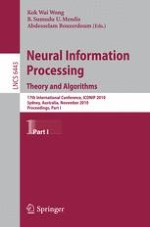The two volume set LNCS 6443 and LNCS 6444 constitutes the proceedings of the 17th International Conference on Neural Information Processing, ICONIP 2010, held in Sydney, Australia, in November 2010. The 146 regular session papers presented were carefully reviewed and selected from 470 submissions. The papers of part I are organized in topical sections on neurodynamics, computational neuroscience and cognitive science, data and text processing, adaptive algorithms, bio-inspired algorithms, and hierarchical methods. The second volume is structured in topical sections on brain computer interface, kernel methods, computational advance in bioinformatics, self-organizing maps and their applications, machine learning applications to image analysis, and applications.
